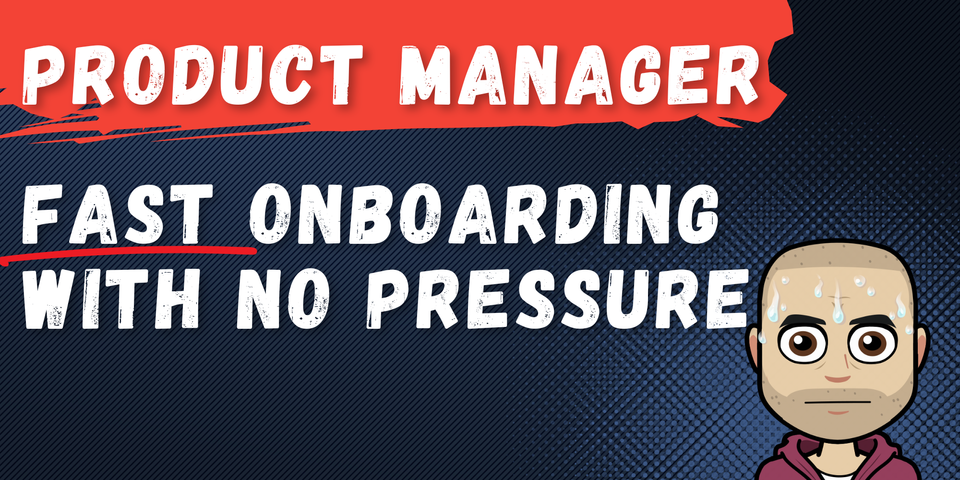Onboard Yourself FAST as a New Product Manager

*While this is written for Product Managers, it's great for anyone starting a new role.
Starting a new role as a Product Manager comes with pressure. There’s that inner clock ticking, pushing you to contribute fast and “carry your own weight.” Even if your boss says, “Take your time,” it’s hard to ignore the pressure. I get it—it’s tough.
One of the first goals is being able to prioritize your team’s work, like sprint planning.
Onboarding fast is one of my superpowers.
Here’s one of the methods I use to do it.
It combines two crucial aspects of product management:
- Personal relationships
- Professional knowledge
And you can start using it right away!
Common Mistakes New PMs Make When Onboarding
Before you seek to provide value, let's make sure you don't harm your chances of success.
Over the years, I’ve made mistakes when joining new teams, and I’ve seen other Product Managers make them too. Here are the common ones:
Sponge Mode (to the extreme)
I’m a big advocate for observing and learning when you first join a team. There’s no one way to do product management, so take the time to observe how your new team operates:
- What’s working?
- What’s not working?
- Who are your teammates?
- What are their strengths and weaknesses?
But don’t fall into the trap of just watching. You’re not a student in a lecture hall. You’re at work, and soon enough, you’re expected to lead.
Common Outcome:
You might have a slow ramp-up. You’ll hesitate to voice opinions or make decisions, which can leave you passive and less effective.
Do Mode (Diving in too fast)
This is the opposite of sponge mode. You start doing things right away without taking time to observe and fit in. You act based on what you’ve done before or what you think is right, without really seeing what works for your new team.
Common Outcome:
You might see early success, but without aligning with the team, you could burn bridges or lose trust.
No Feedback Loop
I’ve failed by not building relationships early. I didn’t ask for help or consult with others. As a result, I made mistakes that could’ve been avoided with feedback.
Common Outcome:
You work hard but in a silo. You get frustrated when your work is rejected or you have to start over because you misunderstood something.
My Method for Onboarding Fast: Externalize your thinking
This method takes the good from all of the above and avoids the downsides. It forces you to:
- Observe and listen.
- Be proactive and take action.
- Build a feedback loop from the start.
Externalizing your thinking will turbocharge your learning!
Here’s how to do it as a new Product Manager using sprint planning:
Observe First
In your first few sprint planning sessions, soak it all in. Take notes, attend meetings, and understand how the team operates.
Create a Draft Sprint Plan
Draft a shitty sprint plan. The goal is to make you figure out:
- What the team is trying to achieve?
- What the team is working on now? Is it moving you towards the goals?
- Where the information lives and how to access it?
- Come up with hypothesis what efforts will move you forward?
Adapt
Use the feedback you get to adjust your thinking. Repeat this consistently, and soon you’ll be contributing confidently—not just in sprint planning but in the team’s day-to-day.
Get Feedback
Find the right person—maybe your manager, a peer, or the team lead—and ask if they can give you 30-45 minutes of feedback on your draft plan. Start the meeting by explaining:
“I want to learn quickly and start contributing. I thought if I shared my logic, you could help point out gaps or misunderstandings. This is just a draft, not a suggestion for our next sprint.”
The Benefits
By following this method, you’ll show that you’re:
- Proactive and willing to take action, rather than waiting.
- Open to feedback and eager to learn.
- A great teammate who builds strong relationships.
This approach helped me get up to speed fast in new roles, understand my team’s priorities, and build strong connections with colleagues.
Externalizing my thinking has become a habit. In meetings, documents, and conversations, I often say:
“Here’s my thinking so far. Please stress-test it, find the gaps, and poke holes in it.”
It’s humbling, but it forces me to focus on outcomes over ego.
Try it out and let me know how it goes!
A few years ago I wrote about few other things I do to onboard myself quickly 👇🏼

If you'd like to get ideas, techniques and tips that will help you build the life you want, subscribe below.
* It takes 10 seconds and I never spam.

Other posts I think will help you












Member discussion